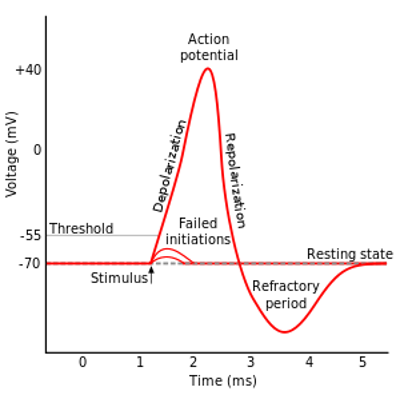Action potentials
Most cells have a membrane potential that exists across the plasma membrane. In neurons and muscle cells this membrane potential can change over time. When a cell is not stimulated, it is in a resting state and the inside of the cell is negatively charged with respect to the outside.
The membrane potential of the resting state is -70mV. This negative charge is due to a high concentration of Na+ outside compared to the K+ inside the cell. This ionic gradient is maintained by the Na/K pump.
For an action potential to take place first the membrane potential must be raised to about -55mV. This is done by a neurotransmitter binding to the postsynaptic neuron and opening some ion channels. Once it reaches -55mV it initiates an irreversible process whereby a large number of Na channels open and cause the cell to depolarise. Once the membrane potential reaches about +40 the Na channels close and the K gates open, the K floods out and the membrane potential falls back again
The membrane potential of the resting state is -70mV. This negative charge is due to a high concentration of Na+ outside compared to the K+ inside the cell. This ionic gradient is maintained by the Na/K pump.
 | |
For an action potential to take place first the membrane potential must be raised to about -55mV. This is done by a neurotransmitter binding to the postsynaptic neuron and opening some ion channels. Once it reaches -55mV it initiates an irreversible process whereby a large number of Na channels open and cause the cell to depolarise. Once the membrane potential reaches about +40 the Na channels close and the K gates open, the K floods out and the membrane potential falls back again
